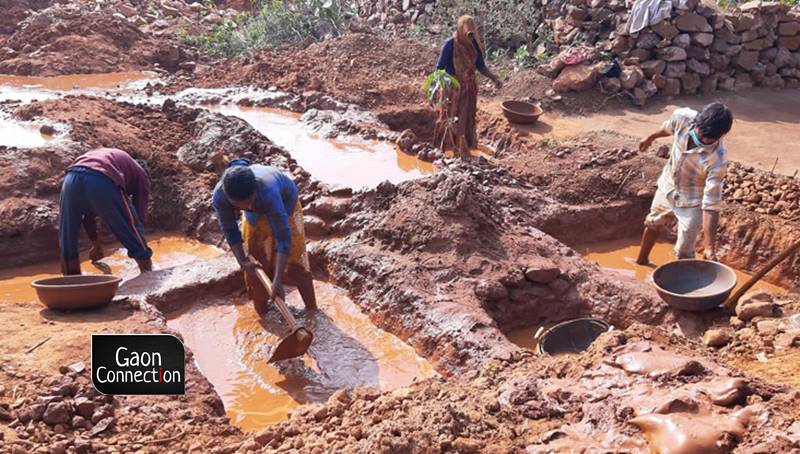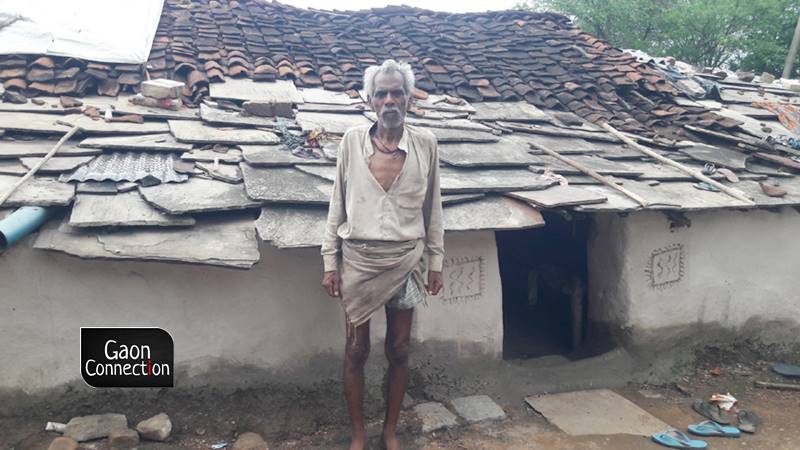The sparkle of Panna’s diamond hides its underbelly of illegal mines and impoverished workers
From poor workers being exploited by the mining mafia to the affluent adventure-seekers who squandered all their wealth and life into the quest of finding diamonds in Panna’s famous mines, the mining business in Madhya Pradesh is far from a story of riches and jewels.

Panna, Madhya Pradesh
The obsession to find a diamond in the mines of Panna has consumed the lives and livelihoods of many. Seventy-year-old Khelayin Sahu, a resident of Janakpur village, is one of them.
“I was 20 years old when I started exploring the local mines for diamonds. I continued to search for diamonds for the next 50 years. I even sold off four acres (1.6 hectares) of agricultural land to fund my adventure.” Sahu narrated the Gaon Connection.
“I have spent my entire life looking for diamonds and all I have found is small deposits of industrial grade diamonds that were sold between hundred and Rs 1,300 rupees. That’s all I have earned out of diamond mining in Panna,” he added.
Panna district in Madhya Pradesh, situated at a distance of about 384 kilometers from state capital Bhopal, is world-famous for its diamond mines. Its rich lands sustain one of the poorest and the most impoverished people in the country. A large chunk of diamond mining in the district is carried out illegally, which is a big loss to the state exchequer and also the local people and the environment.

“Majority of the diamonds found in Panna these days are from illegal mines (about a thousand) that fall outside the permissible limits of the government,” Indrabhan Singh Bundela, an environmental activist in Panna, who has been closely studying diamond mining, told Gaon Connection. According to him, most of the revenue lands in the area have already been exploited for diamond exploration.
“Panna has a large forest area and people secretly enter the forest lands to mine and explore for diamonds. All this is at a great loss to the local ecology. The local labourers are exploited by the mining mafia,” Bundela informed. “Often the forest officials raid these mines and a conflict ensues with the mining mafias. Last year, in Bishramganj forest division’s Rahunia beat, the officials were attacked by the mafia and the deputy ranger along with four other officials were injured in the incident,” he added.

Last February, raids were carried out against illegal diamond mining in Panna Tiger Reserve.
Diamond mining in Panna — legal and illegal
Historically, India was the only source of diamonds in the world for over 3,000 years till diamond deposits were located in Brazil and South Africa, and Panna’s mines accounted for almost 90 per cent of the diamonds available to the world, reads the website of National Mineral Development Corporation.
According to the inventory report of the Indian Bureau of Mines, the total resources of diamond in the country as on 1.4.2015 are estimated at 31,836,091 carats. The estimated sources of diamond are concentrated only in three states. Of these, Madhya Pradesh is credited with 28,709,136 carats (90.17 per cent) having unclassified grade only, followed by Andhra Pradesh with 1,822,955 carats (5.73 per centr), having 235,165 carats gem grade, 58,423 carats industrial grade and 1,529,367 carats unclassified grade, and Chhattisgarh with 1,304,000 carats (4.10 per cent) having 521,600 carats gem grade and 782,400 carats industrial grade.

In Panna district, a region measuring about 70 square kilometres is the official site of the world-famous diamond mines. Two locations — Majhgawan kimberlite pipes and Hinauta kimberlite pipes — are the primary, and legal, sources of the diamond in the district.
Kimberlite pipes are formed when volcanic eruptions form a duct-like opening on the earth’s surface and such sites are the most sought-after locations for diamond explorations as during the explosions (millions of years ago) rare minerals had been thrown up from the earth’s mantle (begins at almost 70 kilometres beneath the earth’s surface) at the site of these ‘pipes’.
These sites are located almost 20 kilometres from the Panna district headquarters and are regulated by the Hyderabad-based public social undertaking (PSU) called National Mineral Development Corporation (NMDC).

The state government grants permission to set up a mining dig in the area by clearing a challan that costs Rs 200 for one year. The government department responsible for the management and administration of these mines is the Diamond Office Panna.
As per the NMDC, the incidence of diamonds in the area is 10 carats (1 carat = 0.2 grams) per 100 tonnes of tuff (a light, porous rock formed by consolidation of volcanic ash) material.
Also Read: ‘It is poison, not water, that comes out of the handpumps’
Panna’s diamond officer Ravi Patel told Gaon Connection that in 2020, a total of 633 land pieces (8 metres X 8 metres) were assigned for diamond mining, whereas 542 such pieces were assigned in 2021.
“If the person who is assigned the land finds diamonds, he has to submit it to the diamond office following which the auction takes place and 11.5 per cent royalty is taken by the government along with a per cent of income tax. The remaining amount is given to the person in whose name the patta (land) was allotted,” Patel explained.
But beyond this legal arrangement of diamond mining, an overwhelming majority of the mines in the area are illegal. A November 2015 report, Mining and conservation displace adivasis in Panna, India, notes that Panna district has up to 700 illegal diamond mines. In 2015 the National Green Tribunal had ordered the closure of illegal diamond mines in the district however such activities continue.
Activists working in the region tell on condition of anonymity that a large chunk of diamond mining in Panna is done illegally and the diamond hunters sell the best quality gems directly to middlemen who further send them to traders in Surat, Mumbai, Hyderabad, etc.
Obsession for diamonds — a nosedive to poverty
“I have been digging for diamonds for more than six to seven years, but didn’t find anything. It’s less of an occupation and more of a hobby, nothing valuable really comes out of the mines. I don’t do it anymore,” Babbu Gond, a digger, told Gaon Connection.

Often the obsession to find a diamond ends with hefty debt as happened with Sahu of Janakpur village. Sahu’s expensive pursuits resulted in a loan of Rs 1,000,000 which he paid off by selling his ancestral land for Rs 1,600,000. It was a distress sale and the real cost of the land, as per him, is stated to be Rs 10 million.
“Whatever was saved after clearing the loan, I put that money back into diamond mining. I couldn’t help but continue looking for the precious pieces. It was a gambling-like addiction to me,” Sahu told Gaon Connection in his frail voice.
“Kuch nahin reh gaya ab, hum buddhhe bhi ho gaye ab to… ab kuch nahin karte hain hum,” the former diamond digger added. (I am left with no money now. I have gotten old as well, I don’t work anymore)
Sahu has four sons and four daughters, all except one son (22-year-old), have got married. “They don’t support me at all. My wife and I survive on the old-age pension. I have no other property except for this small house in the village,” he said.
Despite the rich lands of Panna, the district has one of the poorest people in the country with high malnutrition and disease burden such as silicosis. Apart from the diamond mines, Panna also has a large number of stone mines where local tribal people work and contract silicosis because of inhaling stone dust day and night.
Also Read: Stoned to death: Tribal labourers in Panna’s stone mines continue to die of silicosis
Most of the workers in the illegal diamond mines are underpaid, malnourished and exploited by the mafia but when Gaon Connection attempted to talk to the workers in the mine, they refused to talk as it would risk their only chance of earning a livelihood.
Bundela, the activist, told Gaon Connection that most of these workers, majority of whom are from the tribal communities, work in hazardous conditions at the diamond mines as there’s no other employment opportunity in the area.
Understaffed diamond department
Most of the diamonds furnished from the mines are easily sold off illegally and a shortage of human power to regulate the business is a contributing factor. An official from the diamond office told Gaon Connection on the condition of anonymity that the department is highly understaffed.
“Earlier, the number of officials used to be 32-34. Now only three of them are left. One of them is scheduled to retire next month. How is such an understaffed office supposed to regulate the diamond mining here?” the official said.
Written by Pratyaksh Srivastava

